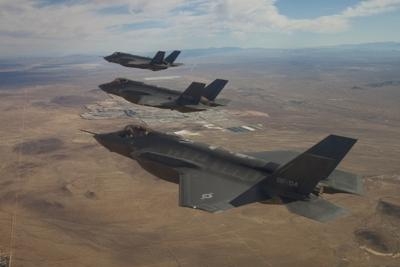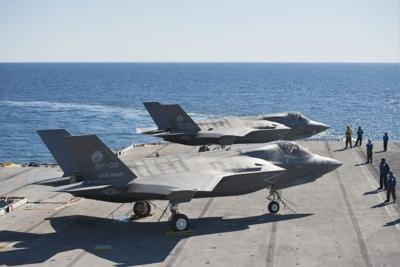Sat, Jan 14, 2012
Nearly 1,000 Test Flights Completed With All Milestones
Achieved
The F-35 System Development and Demonstration 2011 flight test
program resulted in the completion of more test flights and test
points than in any year, according to prime contractor Lockheed
Martin.

The 2011 flight test plan called for the accumulation of 872
flights and 6,622 test points by Dec. 31. For the year, the SDD
program flew 972 flights and tallied 7,823 test points. The F-35A
Conventional Takeoff and Landing (CTOL) variant flew 474 flights
and accomplished 3,600 test points. The F-35B Short
Takeoff/Vertical Landing (STOVL) variant accomplished 333 flights
and 2,636 test points. The F-35C Carrier Variant (CV) flew 165
flights and tallied 1,587 test points. Along with this, the STOVL
executed 268 vertical landings. The cumulative 2011 milestones were
achieved through a combination of planned test flights and test
points along with test flights and test points added throughout the
year.
“The success of the flight test program is the result of a
team of dedicated government and contractor professionals,”
said Larry Lawson, Lockheed Martin’s F-35 program executive
vice president and general manager. “The test team continues
to gain momentum and they will build upon this success for an even
better 2012. I couldn’t be prouder of the team.”
The overall F-35 SDD flight test program plan calls for the
verification of 59,585 test points through developmental test
flights by Dec. 31, 2016. Through 2011, the flight test team has
accomplished 12,728 test points or 21.4 percent of overall testing
requirements.
“These achievements speak to the rapid maturation of the F-35
program and to our team’s commitment to performing with
excellence,” said J.D. McFarlan, vice president of F-35 Test
and Verification. “We will now turn towards 2012, expanding
the flight envelope as we continue to demonstrate the F-35’s
excellent flight characteristics for all three variants.”

Major flight test achievements in 2011 include:
- A major highlight for October was the completion of F-35B short
takeoff/vertical landing (STOVL) ship suitability testing aboard
the USS WASP (LHD-1) off the coast of Virginia. The test began when
BF-2 executed the first shipboard vertical landing on Oct. 3. The
next day, BF-2 executed the first short takeoff from the WASP.
During the third week of sea trials, BF-2 and BF-4 operated
simultaneously on the ship. Combined, they accomplished 72 short
takeoffs and 72 vertical landings during the three-week testing
period.
- The mission systems test aircraft performed Block 1A and Block
1B software testing including demonstrating Communication
Navigation and Identification (CNI) range and accuracy and
integrated Electro-Optical Targeting System testing that included
Tactical FLIR (Forward Looking Infra-Red) and combat laser firing.
The software also displayed imagery from the Distributed Aperture
System on the Helmet Mounted Display. Further testing accomplished
radar search and target tracking, Synthetic Aperture Radar Mapping,
Electronic Warfare testing, and multi-sensor fusion of four
sensors. In addition, baseline Radar Cross Section signature
testing was accomplished on three mission system aircraft.
- On Nov. 18, CF-3, an F-35C test aircraft, conducted the first
F-35 launch from the Navy’s new Electromagnetic Aircraft
Launch System (EMALS). Testing the F-35C on EMALS marked the
beginning of the process to integrate the carrier variant with the
future carrier fleet aircraft launching system.
- The F-35B STOVL jets conducted 268 vertical landings (VLs) in
2011 compared to 10 VLs in 2010. F-35B aircraft also completed 395
short takeoffs (STOs) this year.
- AF-1 achieved the F-35’s maximum design limit speed of
Mach 1.6 for the first time on Oct. 25.
- Jet Blast Deflector (JBD) testing was performed by F-35C
Lightning II carrier variant (CV) aircraft CF-2 at Joint Base
McGuire-Dix-Lakehurst, N.J. from June 25-July 8. CF-2 successfully
completed this portion of tests required to ensure the F-35C is
compatible aboard an aircraft carrier.
- AF-6 and AF-7 completed Maturity Flight testing of the training
syllabus software at Edwards Air Force Base, Calif., designed to
simulate operating an F-35 without a mission control room.
The F-35 program successfully performed aerial refueling testing
with KC-135 and KC-10 aircraft.
More News
Aero Linx: International Federation of Airworthiness (IFA) We aim to be the most internationally respected independent authority on the subject of Airworthiness. IFA uniquely combi>[...]
Ultrahigh Frequency (UHF) The frequency band between 300 and 3,000 MHz. The bank of radio frequencies used for military air/ground voice communications. In some instances this may >[...]
A Few Questions AND Answers To Help You Get MORE Out of ANN! 1) I forgot my password. How do I find it? 1) Easy... click here and give us your e-mail address--we'll send it to you >[...]
From 2019 (YouTube Edition): Learning To Paint Without Getting Any On Your Hands PPG's Aerospace Coatings Academy is a tool designed to teach everything one needs to know about all>[...]
Also: Sustainable Aircraft Test Put Aside, More Falcon 9 Ops, Wyoming ANG Rescue, Oreo Cookie Into Orbit Joby Aviation has reason to celebrate, recently completing its first full t>[...]
 ANN's Daily Aero-Linx (05.06.25)
ANN's Daily Aero-Linx (05.06.25) ANN's Daily Aero-Term (05.06.25): Ultrahigh Frequency (UHF)
ANN's Daily Aero-Term (05.06.25): Ultrahigh Frequency (UHF) ANN FAQ: Q&A 101
ANN FAQ: Q&A 101 Classic Aero-TV: Virtual Reality Painting--PPG Leverages Technology for Training
Classic Aero-TV: Virtual Reality Painting--PPG Leverages Technology for Training Airborne 05.02.25: Joby Crewed Milestone, Diamond Club, Canadian Pilot Insurance
Airborne 05.02.25: Joby Crewed Milestone, Diamond Club, Canadian Pilot Insurance




